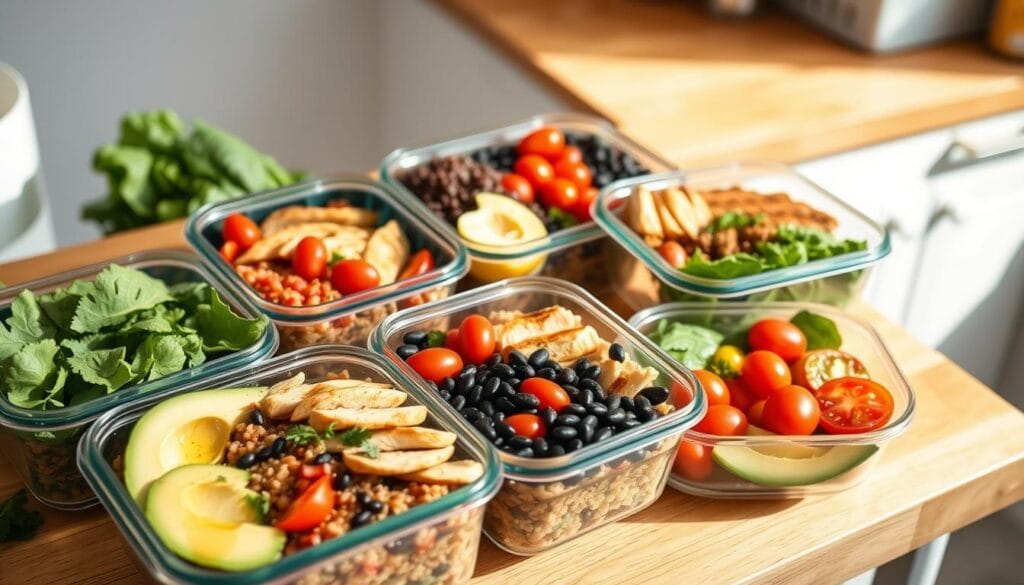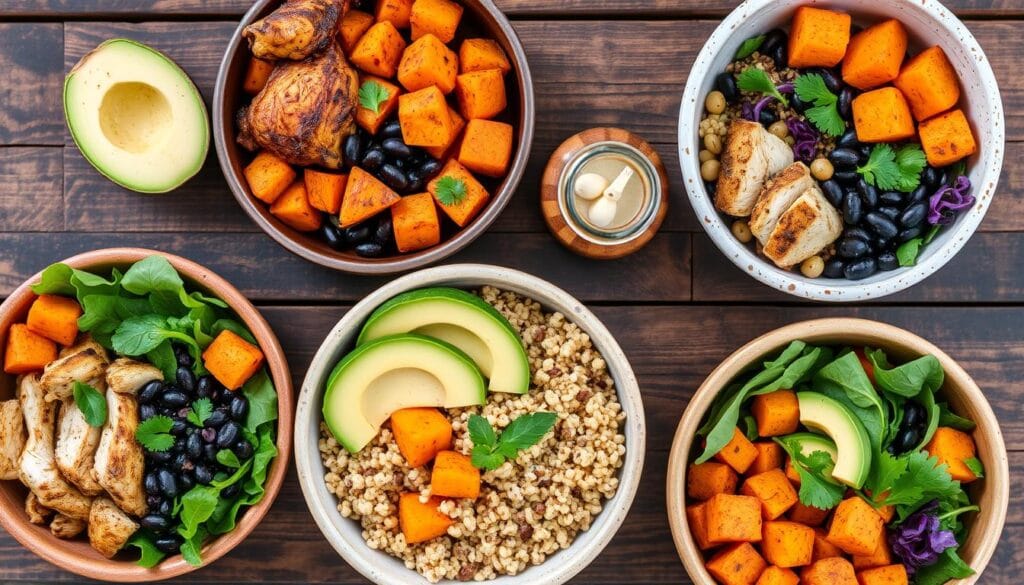Every athlete knows the battle of muscle recovery isn’t won in the gym—it’s won in the kitchen. Your post-workout nutrition is key to your fitness journey. Protein bowl recipes are your secret weapon for muscle recovery.
Imagine turning your exhausting training sessions into powerful muscle-building opportunities. This is thanks to strategic, delicious high-protein meals.
As an endurance athlete or fitness enthusiast, you know post-workout nutrition is more than eating. It’s about strategic refueling. Protein bowl recipes offer a perfect blend of nutrients. They support muscle recovery, reduce inflammation, and prepare your body for the next workout.
From chicken and quinoa combinations to salmon poke bowls and plant-based alternatives, these meals are your performance optimization toolkit. Each recipe is carefully crafted. It delivers essential nutrients exactly when your body needs them most.
Table of Contents
Understanding Post-Workout Nutrition Needs
Your post-workout nutrition is key for muscle recovery and fitness. Knowing how to fuel your body after exercise can boost your results. It helps you reach your fitness goals faster.
Role of Protein in Muscle Recovery
Protein is essential for muscle repair and growth. The International Society of Sports Nutrition suggests eating 20 to 40 grams of protein every 3 to 4 hours. Nutrient timing is important because your muscles absorb nutrients best right after exercise.
- Aids in muscle tissue repair
- Supports muscle protein synthesis
- Reduces muscle soreness
- Promotes faster recovery
Optimal Nutrient Timing After Exercise
Studies show that eating within 2 hours after working out helps a lot with muscle recovery. Your body is most ready to take in nutrients during this time. It’s the best moment to add essential macronutrients.
“Nutrition is the foundation of performance and recovery” – Sports Nutrition Expert
Importance of Balanced Macronutrients
A good post-workout meal should have quality proteins, complex carbs, and healthy fats. The ISSN says to eat 0.4 grams of carbs per pound of body weight in the first 4 hours after exercise. This helps restore energy stores well.
- Protein for muscle repair
- Carbohydrates for energy restoration
- Healthy fats for hormonal balance
By planning your post-workout nutrition well, you can improve muscle recovery and performance. It also supports your long-term fitness goals.
Essential Components of a Recovery Protein Bowl
Making the perfect recovery protein bowl means picking the right ingredients. Your post-workout meal is key for fixing muscles and getting your energy back. Knowing what to include helps you make meals that boost your athletic performance.
A good recovery protein bowl has the right mix of nutrients. Experts say to focus on certain foods that help your muscles heal and your energy come back.
- Lean Protein Source (20-40 grams)
- Complex Carbohydrates (1-1.2 grams/kg)
- Healthy Fat Sources
- Micronutrient-Rich Vegetables
When you eat your recovery meal matters a lot. Studies show eating the right foods within 30-45 minutes after working out helps a lot. It helps your muscles get back their energy faster and cuts down on recovery time.
| Ingredient Category | Recommended Quantity | Recovery Benefits |
|---|---|---|
| Protein | 20-40 grams | Muscle repair and growth |
| Carbohydrates | 1-1.2 g/kg bodyweight | Glycogen replenishment |
| Electrolytes | 200-2000 mg | Hydration and muscle function |
“Nutrition is the foundation of recovery. What you consume after training determines how quickly you’ll bounce back.” – Sports Nutrition Expert
Think about adding things like Greek yogurt, quinoa, and tart cherry juice to your bowl. These ingredients help make a recovery bowl that supports your fitness goals.
High-Protein Base Options for Recovery Bowls
Making the perfect recovery bowl starts with the right protein base. Your post-workout meal needs ingredients that help repair muscles and give you energy. Whether you’re an athlete or someone who loves to stay fit, knowing about different high-protein bases can change how you recover.
Quinoa and Ancient Grains
Ancient grains are great for recovery bowls because of their nutritional value. Quinoa is a standout because it has all nine essential amino acids. Other grains like amaranth and farro also have a lot of protein and complex carbs that help muscles grow back.
- Quinoa: 8 grams of protein per cup
- Amaranth: 9 grams of protein per cup
- Farro: 10 grams of protein per cup
Lean Protein Sources
Lean proteins are key for muscle repair in recovery bowls. Grilled chicken, turkey, and fish are good choices because they have a lot of protein but not much fat. These help reduce inflammation and help rebuild muscle tissue.
| Protein Source | Protein per 3 oz | Additional Benefits |
|---|---|---|
| Chicken Breast | 26 grams | Low in saturated fat |
| Turkey | 24 grams | Rich in selenium |
| Salmon | 22 grams | Omega-3 fatty acids |
Plant-Based Protein Alternatives
Plant-based proteins are great for recovery bowls. Tofu, tempeh, legumes, and seitan have a lot of protein and are good for vegetarians and vegans. They help with muscle recovery and add extra nutrients.
“Nutrition is the foundation of muscle recovery. Choose your protein wisely.” – Sports Nutrition Expert
By mixing and matching these high-protein foods, you can make tasty recovery bowls that help you reach your fitness goals.
Best Protein Bowl Recipes for Athletes
Athletes looking for powerful protein-rich recipes will find delicious meal prep solutions. These meals support muscle recovery and optimize sports nutrition. They are designed to offer maximum nutritional value with little preparation time.
Here are some amazing protein bowl recipes. They turn athlete meal prep into a quick and nutritious experience:
- Tropical Power Bowl: Packed with 38g protein
- Acai base
- Fresh pineapple chunks
- Coconut yogurt
- Berry Protein Blast: Delivers 49g protein
- Greek yogurt foundation
- Mixed berry medley
- Almond butter drizzle
- Chocolate Peanut Performance Bowl: Provides 59g protein
- Cocoa powder
- Greek yogurt
- Natural peanut butter
Each recipe can be made in under 30 minutes. They are ideal for busy athletes. By using ingredients like olive oil, arugula, and spinach, you’ll increase your nutrient intake. Plus, you’ll enjoy delicious meals.
“Nutrition is the foundation of athletic performance” – Sports Performance Experts
Here are some tips for customizing your protein bowls:
- Replace brown rice with cauliflower rice to reduce carbohydrates
- Add chili flakes for metabolism boost
- Include lean proteins like ground beef or kidney beans
With an average of 37.3g protein per serving, these protein bowls are your secret weapon. They help with muscle recovery and keep you energized.
Customizing Your Recovery Bowl with Superfoods
Make your post-workout meal a powerhouse with superfoods. They turn your protein bowl into a nutrient-dense meal. This supports muscle recovery and overall health.
Anti-inflammatory Ingredients to Boost Recovery
Use superfoods to fight exercise-induced inflammation. They offer a nutritional boost. Here are some top anti-inflammatory foods for your recovery bowl:
- Turmeric: A potent natural anti-inflammatory spice
- Ginger: Reduces muscle soreness and supports joint health
- Berries: Rich in antioxidants that fight inflammation
- Chia seeds: Omega-3 fatty acids for natural healing
Performance-Boosting Add-ins
Add superfoods for extra energy and muscle recovery support:
- Spirulina: Dense nutrient profile with complete protein
- Maca powder: Natural energy booster
- Hemp seeds: Protein-packed and rich in essential minerals
Strategic Seasoning Choices
Use healthy seasonings to add flavor without extra calories. Try herbs, spices, and citrus zests. They make your meal both tasty and supportive of your fitness goals.
“Food is not just fuel, it’s information. What you eat talks to your body.” – Dr. Mark Hyman
Pro tip: Mix and match superfoods and seasonings. Create a recovery bowl that’s as unique as your workout. Your body will love the nutrient-rich, delicious fuel!
Quick and Easy Meal Prep Protein Bowls
Healthy meal planning doesn’t have to be hard. Meal prep protein bowls are perfect for busy athletes and fitness fans. They help you eat well without spending too much time.

Making quick recipes for after workouts is easy and tasty. Let’s look at some protein bowl tips to boost your nutrition:
- Batch cook lean proteins on weekends
- Prepare versatile grain bases in advance
- Chop vegetables for multiple meals
- Use meal prep containers for easy storage
Your perfect protein bowl can be very nutritious. Here’s a breakdown of a protein-rich meal prep bowl:
| Ingredient | Quantity | Protein | Calories |
|---|---|---|---|
| 93/7 Lean Meat | 200g | 55g | 487 |
| Mixed Vegetables | 3 cups | 5g | 90 |
| Brown Rice | 200g | 5g | 280 |
“Meal prep is not just about saving time—it’s about investing in your health and performance.” – Nutrition Expert
For efficient meal prep, use multifunctional ingredients like chicken or tofu. Season them differently for variety. Also, invest in good meal prep containers. Spend 2-3 hours on weekends to prep your meals.
With these tips, you’ll change how you think about nutrition. You’ll have quick, healthy, and protein-rich meals ready anytime.
Vegetarian and Vegan Recovery Bowl Options
Vegan athletes are changing the game with their plant-based recovery bowls. These bowls are packed with muscle-supporting nutrients. You don’t need animal proteins to recover well. Plant-based proteins offer all the nutrients you need.
Plant-Based Protein Combinations
Making complete proteins is simpler than you think. You can mix vegetarian proteins to get all essential amino acids. Here are some great protein pairs:
- Rice and beans
- Quinoa and lentils
- Hummus with whole grain pita
- Nut butter on sprouted bread
Complete Protein Sources
Some plant-based foods are superfoods for vegan athletes. Quinoa, soy products, and buckwheat are top choices. They give your body all nine essential amino acids for muscle recovery.
“Nutrition is not about perfection, but about balance and making informed choices.” – Anonymous Nutritionist
Nutritional Optimization Tips
To boost your plant-based nutrition, mix things up and choose wisely. Add nutrient-rich veggies, fortified plant milks, and protein-rich seeds like chia and hemp. Nutritional yeast is great for extra protein and B-vitamins.
Your recovery bowl can be a tasty, nutrient-rich meal. It supports muscle repair and growth. This shows that vegetarian proteins can meet any athlete’s nutritional needs.
Protein Bowl Recipes for Different Training Intensities

Your training nutrition needs change a lot based on how hard you work out. To make the best recovery meals, you need to know how different exercises need different proteins and nutrients.
Endurance athletes need a special approach to protein bowls. Your meals after working out should help refill glycogen stores and give some protein. Bowls with quinoa, lean proteins like chicken or fish, are great for marathon runners and cyclists.
“The right recovery meal can make the difference between good and exceptional athletic performance.”
Strength training needs a different kind of nutrition. Your protein bowls should have more protein and smart choices of ingredients:
- Greek yogurt base with mixed berries
- Whey protein powder as a supplement
- Salmon with brown rice
- Avocado for healthy fat integration
HIIT athletes need meals that quickly fix muscle glycogen and help with repair. A protein bowl with many nutrients can help you recover faster after working out.
| Training Type | Protein Recommendation | Key Ingredients |
|---|---|---|
| Endurance | 15-20g protein | Quinoa, chicken, sweet potato |
| Strength Training | 20-30g protein | Greek yogurt, whey, berries |
| HIIT | 25-35g protein | Salmon, brown rice, avocado |
Remember, everyone’s recovery needs are different. Pay attention to how your body feels and change your protein bowl as needed. This will help you get the most out of your training and muscle recovery.
Conclusion
Your journey to better post-workout nutrition ends with protein bowls. These meals are not just tasty; they help your body recover and perform better. You can make different kinds of bowls, like Salmon Power Bowls or Mediterranean Buddha Bowls, to meet your fitness needs.
Protein bowls do more than just feed you. They help repair muscles and give you energy. With ingredients like lean chicken, quinoa, and black beans, each bowl has about 390 calories and 21g of protein. They’re perfect for athletes of all levels.
Try new things with protein bowls. Use different proteins, add organic foods, and make your own recipes. Preparing meals on Sundays can save you time and keep your nutrition consistent. Mixing things up keeps your meals exciting and meets your body’s needs.
Good nutrition is key to your athletic success. Protein bowls are a tasty, flexible way to recover after workouts. By choosing these meals, you’re fueling your fitness journey with care and flavor.

